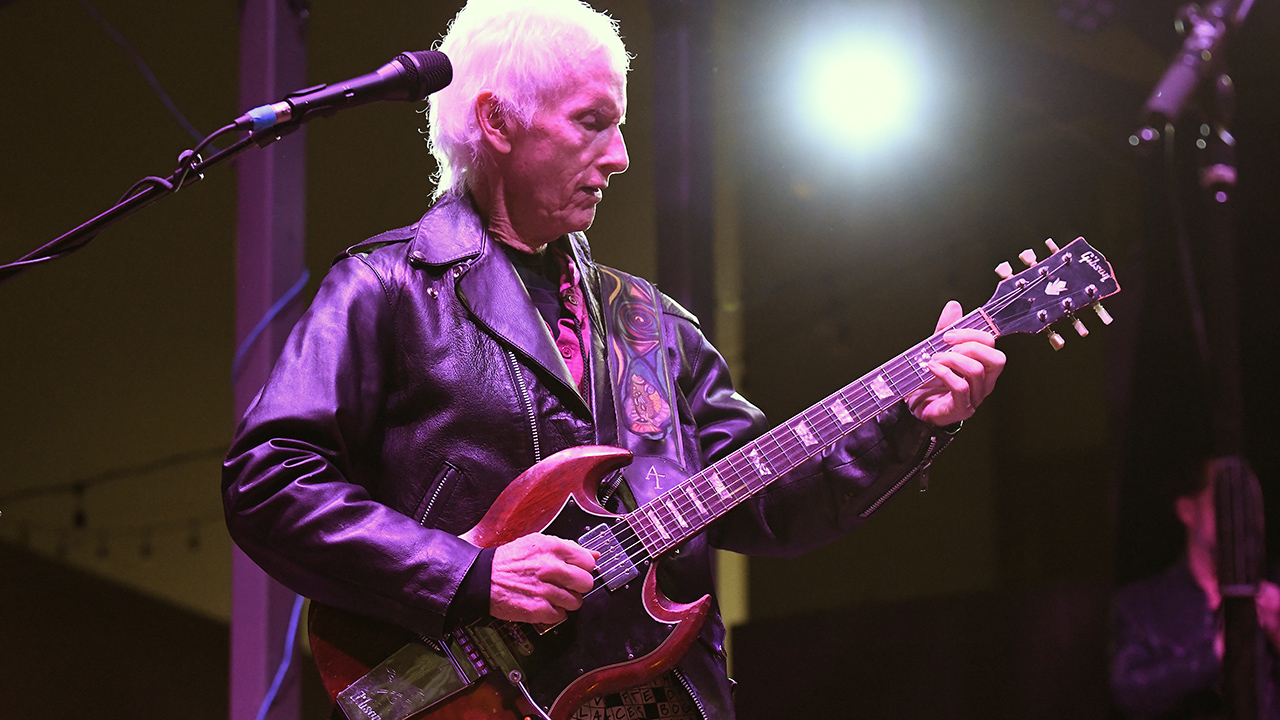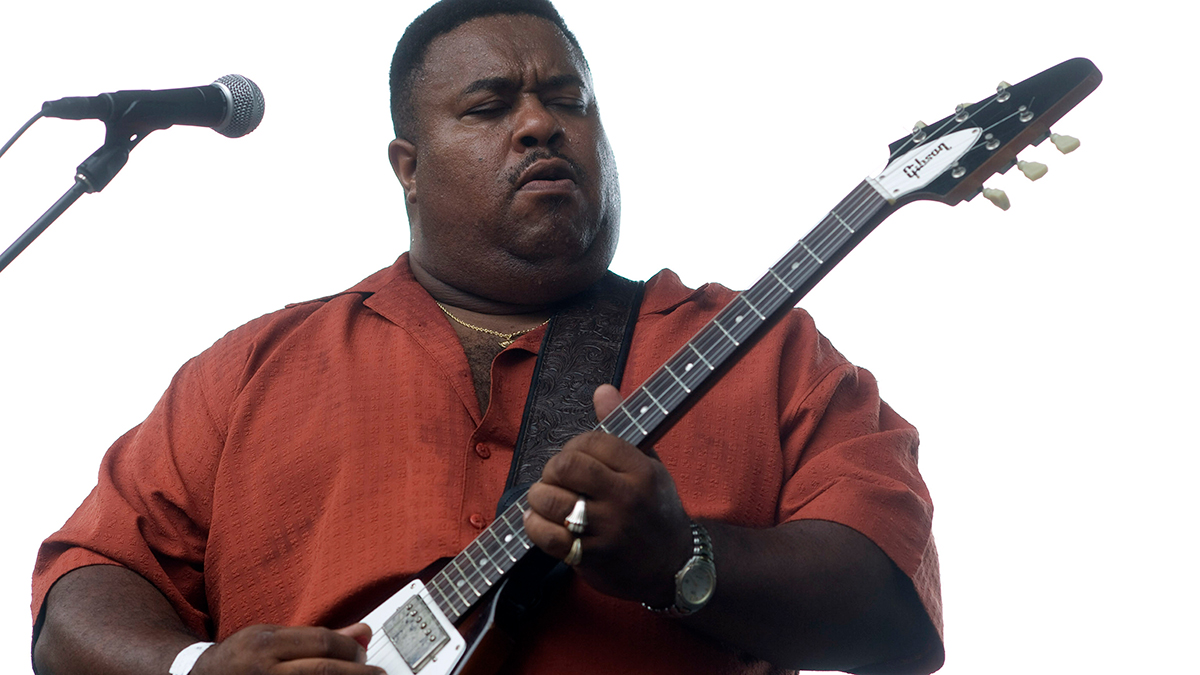“It looked cool – especially when you took acid… those horns looked like the devil!”: The Doors’ Robby Krieger on his love of the SG, studio accidents and a challenging move away from his signature fingerstyle
The influential Doors guitarist is back with a new record. He explains how he’s (almost) found comfort in a new way of playing

In January 1983, Guitar World featured Robby Krieger on its cover, wielding a jazz box instead of his usual Gibson SG, and the headline “The greatest guitarist you’ve never heard of.”
Today it’s hard to imagine that the man who helped build some of the greatest blues-meets-acid-meets-psych rock ever created could be thought of as underrated – but back then it was true.
Four decades on there’s nothing but reverence showered upon the 77-year-old rocker, who played alongside Jim Morrison, Ray Manzarek and John Densmore in The Doors. Stars like The Cult’s Billy Duffy and Alice in Chains’ Jerry Cantrell have name-checked Krieger, noting his tone, feel, and ability to blend blues and psych into something dark, without ever going full-on metal.
I still love the blues, jazz, reggae, soul, and anything with a guitar. The most important thing is to always sound like me – whatever that means!
Asked about if he ever imagined he’d be named as an influence by such players, Krieger smirks. “No, I never could have. But to be honest, I never thought about it! It’s been cool to have all these bands tell me that The Doors and what I was doing influenced them.
“But there’s no secret to what I do: I keep trying to do something different. And as far as The Doors go, we were lucky to have four people that came together, fit well, and made music that was just different enough to be remembered.”
Krieger is at it again with his latest project, Robby Krieger & the Soul Savages, who release their self-titled debut record on January 19 via Mascot Label Group. Has he changed his approach?
“No, not much,” he says. “I still love the blues. I think, at least in some way, every guitar player does. But the biggest thing for me beyond inspiration – no matter where I get it from – is that I never try and copy anybody.
All the latest guitar news, interviews, lessons, reviews, deals and more, direct to your inbox!
“I still love the blues, jazz, reggae, soul, and anything with a guitar. The most important thing is to always sound like me – whatever that means!”
How did Robby Krieger & the Soul Savages come into being?
“I built a studio in the Glendale, California, area about five years ago, and I met some musicians who also lived there. There’s one guy called Ed Roth, a great keyboard player who has played with Annie Lennox of the Eurythmics. Ed knew a bass player named Kevin ‘Brandino’ Brandon, whom I’d used on some of my albums in the past, so it made sense.
“We started jamming and it was great. That’s when we met Franklin Vanderbilt, who plays drums. He’s played with Lenny Kravitz; he’s a great drummer and he rounded out the band. From there it was a matter of working out the songs together, jamming some more, and figuring out some sounds that sounded pretty neat.”
Has your general approach to riffs and solos evolved?
“On this new album with the Soul Savages, the basic process is that we’d lay down a track, and once we got the song dialed in I’d try to put the rhythm part down. After that, I’d sometimes put a lead on at the same time; other times, it was later.
“If I did put a lead down simultaneously it would leave a hole in the rhythm section, so the ideal way is to do the solo after the fact. Often, we’d do the track at one studio, and then I’d bring it home, go into my studio, and that’s where I’d work on my solos.”
How does your current process compare to your days with The Doors?
Back in the Doors days, I never used a pick; I’d always play fingerstyle. I didn’t get into using picks until the ‘70s
“The main change is I’m using a pick more nowadays. Back in the Doors days, I never used a pick; I’d always play fingerstyle. I didn’t get into using picks until the ‘70s, but even then I still used my fingers on the old right hand often. The main difference would be using a pick and trying to get the right speed going with it.”
What led you to primarily play fingerstyle back then?
“Fingerstyle is still the most comfortable. I initially played flamenco guitar, and Wes Montgomery, who I loved, never used a pick – well, he didn’t use one early on. But later I read an article on him, and by then he’d started using a pick.
“He was asked why and said, ‘If I had to do it over again, I’d use a pick because it’s easier on the fingers.’ I felt bad for him when I read that, but I also understood what he meant because fingerstyle can leave your fingers and thumbs all thrashed up and your nails ragged.
“So at that point I said to myself, ‘Okay, I’m going to try and use a pick too.’ It wasn’t easy for quite a few years; but eventually I became comfortable enough to where I’m not actually comfortable, but I can do it just the same.”
Your dabbling with flamenco can be heard in your playing and compositions, along with your classical and jazz leanings.
“Yeah, that’s most definitely true. But you also have to remember that Ray Manzarek was very into classical music, which affected the composition too. All of that definitely was a significant product of me in those styles; there’s no doubt about that.”
Did the transition from fingerstyle to pick impact your tone?
“People ask me about the secret to my tone… for starters, there’s no secret! Everyone has their own sound; and with me, a lot of that definitely came from me playing fingerstyle. But my viewpoint on tone has always been that I have my own sound, and everybody else should too. If your mother can’t recognize you when she hears your sound on the radio, then you don’t have your own sound.”
You’re well-known for using a Gibson SG, but are you deploying any other gear now?
“I think you can tell that there are a few cuts on the new album that have an electric sitar on them – I’ve been messing around with that quite a bit. I also have a few Gibson ES-355s, but to this day I mostly keep to my SG.”
And your original SG was stolen at some point, right?
“That’s right. But I was lucky enough to find another like it. I’m still looking for my original SG, though. If anyone out there knows anything about that, please call me. Seriously! But I was lucky to find another that’s pretty much the same, which is a ’67 Gibson SG. It’s pretty much my main guitar.”
One day I saw Chuck Berry play at the Santa Monica Civic Center, and he played this beautiful cherry red Gibson ES-335. The next day I decided to trade in one of my flamenco guitars for an [electric]
What first drew you to the SG?
“There was just something about it. Back when I was playing flamenco, I didn’t have an electric guitar. Then, one day, I saw Chuck Berry play at the Santa Monica Civic Center, and he played this beautiful cherry red Gibson ES-335.
“Next day I decided to trade in one of my flamenco guitars for an ES-335. But as it turned out, the ES-335 was too expensive, and the only guitar I could afford was a Gibson SG. I guess what drew me to it was that it looked kind of cool, you know? I liked the look of it with the double cutaway and the horns. I also liked that you could play it easily and get high up on the neck.
“But now I think of it, the first one wasn’t an actual SG; it was a Les Paul Jr. with the black pickups. It looked cool – especially when you took acid… those horns looked like the devil!”
How did the SG impacted your guitar sound with The Doors?
“Well, this is in retrospect – I wouldn't have known as it was happening – but I think the sound has more to do with how I played the SG than the actual SG itself. It’s always about how you play rather than what you play.
“I think the SG had a smoother sound compared to the Fender guitars of the day. The Fender stuff was twangier, and I never was a fan of that. I always have gone for smoother sounds, which I could get with the Gibson.”
Do you have a favorite solo or riff from your Doors days?
I did four or five solos and kept overdubbing, and the engineer mistakenly played two of them at once. We all loved it!
“There are so many that I love. But When the Music’s Over from Strange Days has long been one of my favorites. That song is long, so it has two solo; and if you notice, one pans to the left and one pans to the right. I didn’t plan it that way – what happened was I did four or five solos and kept overdubbing, and the engineer, Bruce Botnick, mistakenly played two of them at once. We all loved it!
“But it’s always been hard to execute live, and my son has been helping with the other part lately. I've been on the left-hand side lately, so maybe that’s my favorite side. But to this day, replicating the solos in When the Music’s Over is a massive challenge in person.”
- Robby Krieger and the Soul Savages is available for pre-order now.
Andrew Daly is an iced-coffee-addicted, oddball Telecaster-playing, alfredo pasta-loving journalist from Long Island, NY, who, in addition to being a contributing writer for Guitar World, scribes for Bass Player, Guitar Player, Guitarist, and MusicRadar. Andrew has interviewed favorites like Ace Frehley, Johnny Marr, Vito Bratta, Bruce Kulick, Joe Perry, Brad Whitford, Tom Morello, Rich Robinson, and Paul Stanley, while his all-time favorite (rhythm player), Keith Richards, continues to elude him.






